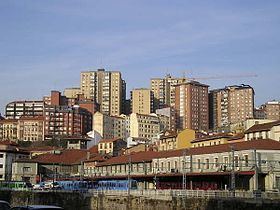Country Spain City Bilbao Population 33.346 inhabitants Province Biscay | Autonomous community Basque Country District Begoña Demonym(s) Santutxutarra | |
 | ||
Restaurants Galtzagorri, Danon Etxea, Luberri Taberna, La Bodeguilla, Cervecería Gambrinus Santutxu | ||
Santutxu (spelled as Santuchu when written in Spanish). It belongs to the 4th urban district, named Begoña. It is a popular residential neighbourhood which has also a relatively strong commercial area, including three food retail markets. It belongs to the 4th urban district, named Begoña, which is completed by three neighbourhoods, Santutxu, Begoña and Boleta. Many believe Santutxu to be the most densely populated neighbourhood in Europe, despite all evidence to the contrary, but while the neighbourhood association has campaigned for more resources to be put in place in District 4 (comprising Santutxu, Begoña, and Boleta), Santutxu is not even the most densely populated neighbourhood within Bilbao.
Contents
- Map of Santutxu Bilbao Biscay Spain
- History
- Famous people from Santutxu
- Events in Santutxu
- Organisations related with Santutxu
- Bilbao Underground
- References
Map of Santutxu, Bilbao, Biscay, Spain
History
Santutxu (meaning little Saint in Basque), owes its name to a hermitage which was dedicated to Francisco de Paula. This hermitage was founded in 1737 by Francisco Fernando de Barrenechea among others, and was built with the sole purpose of enabling its colonists to hear masses without moving to Begoña church. Since both the hermitage and the Saint figure inside were small sized, it was popularly given the name Santutxu, Santuchu in Spanish. Moreover, the word Santutxu is the result of the union of two basque words, santu which means holy in basque and txu which is a diminutive suffix, also in basque.
In those first years, every second of April was celebrated in honor of San Francisco de Paula with a Major Mass of great solemnity. Representatives of the Hall of the República de Begoña would attend this event, as well as members of the clergy that would take part in every religious event back in those days, where rockets, drumming and of course, a typical homemade Basque wine named txakoli or chacolí in Spanish, were the order of the day.
In 1925, the church of Begoña was annexed (and with it, the neighbourhood of Santutxu) to Bilbao. In the XX century it went from being a semi-rural zone with great sandlots, to a highly populated neighbourhood, especially after the building and demographic growth of the 1960s.
Luis Briñas Public school is a detached building in Santutxu, located on Iturriaga street, near the Campa de Basarrate. It is monumentally protected and was designed by the architect Pedro Ispizua Susunaga (Bermeo, 1895 - Bilbao, 1976), who also designed the del Tigre, the Mercado de la Ribera, the pergola of Parque Casilda Iturrizar or the Kiosco del Arenal.
In Santutxu, according to the Bilbao Hall census data of 2008, there are 33,346 inhabitants.
Famous people from Santutxu
Events in Santutxu
Organisations related with Santutxu
Bilbao Underground
There are two underground stations (Metro Bilbao):
